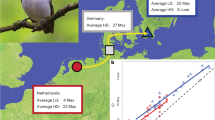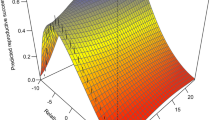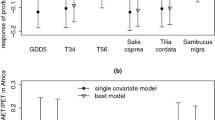Abstract
Spring temperatures in temperate regions have increased over the past 20 years1, and many organisms have responded to this increase by advancing the date of their growth and reproduction2,3,4,5,6,7. Here we show that adaptation to climate change in a long-distance migrant is constrained by the timing of its migratory journey. For long-distance migrants climate change may advance the phenology of their breeding areas, but the timing of some species’ spring migration relies on endogenous rhythms that are not affected by climate change8. Thus, the spring migration of these species will not advance even though they need to arrive earlier on their breeding grounds to breed at the appropriate time. We show that the migratory pied flycatcher Ficedula hypoleuca has advanced its laying date over the past 20 years. This temporal shift has been insufficient, however, as indicated by increased selection for earlier breeding over the same period. The shift is hampered by its spring arrival date, which has not advanced. Some of the numerous long-distance migrants will suffer from climate change, because either their migration strategy is unaffected by climate change, or the climate in breeding and wintering areas are changing at different speeds, preventing adequate adaptation.
This is a preview of subscription content, access via your institution
Access options
Subscribe to this journal
Receive 51 print issues and online access
$199.00 per year
only $3.90 per issue
Buy this article
- Purchase on Springer Link
- Instant access to full article PDF
Prices may be subject to local taxes which are calculated during checkout


Similar content being viewed by others
References
Houghton, J. T. et al. (eds) Climate Change 1995 (Cambridge Univ. Press, Cambridge, 1996).
Beebee, T. J. C. Amphibian breeding and climate. Nature 374, 219–220 (1995).
Crick, H. Q. P., Dudley, C., Glue, D. E. & Thomson, D. L. UK birds are laying eggs earlier. Nature 388, 526 (1997).
Crick, H. Q. P. & Sparks, T. H. Climate change related to egg-laying trends. Nature 399, 423–424 (1999).
Forchhammer, M. C., Post, E. & Stenseth, N. C. Breeding phenology and climate. Nature 391, 29–30 (1998).
McCleery, R. H. & Perrins, C. M. …temperature and egg-laying trends. Nature 391, 30–31 (1998).
Brown, J. L., Li, S. H. & Bhagabati, N. Long-term trend toward earlier breeding in an American bird: a response to global warming? Proc. Natl Acad. Sci. USA 96, 5565–5569 (1999).
Gwinner, E. Circannual clocks in avian reproduction and migration. Ibis 138, 47–63 (1996).
Visser, M. E., van Noordwijk, A. J., Tinbergen, J. M. & Lessells, C. M. Warmer springs lead to mistimed reproduction in great tits (Parus major). Proc. R. Soc. Lond. B 265, 1867–1870 (1998).
Harrington, R., Woiwod, I. & Sparks, T. H. Climate change and trophic interactions. Trends Ecol. Evol. 14, 146–150 (1999).
Visser, M. E. & Holleman, L. J. M. Warmer spring disrupt the synchrony of Oak and Winter Moth phenology. Proc. R. Soc. Lond. B 268, 289–294 (2001)
Przybylo, R., Sheldon, B. C. & Merila, J. Climatic effect on breeding and morphology: evidence for phenotypic plasticity. J. Anim. Ecol. 69, 395–403 (2000).
Stevenson, I. R. & Bryant, D. M. Climate change and constraints on breeding. Nature 406, 366–367 (2000).
Lundberg, A. & Alatalo, R. V. The Pied Flycatcher (T. & A. D. Poyser, London, 1992).
Alatalo, R. V., Lundberg, A. & Glynn, C. Female Pied Flycatchers choose territory quality and not male characteristics. Nature 323, 152–153 (1986).
Both, C. Density dependence of avian clutch size in resident and migrant species: is there a constraint on the predictability of competitor density? J. Avian Biol. 31, 412–417 (2000).
Falconer, D. S. & Mackay, F. T. C. An Introduction to Quantative Genetics 4th edn (Longman Higher Education, Essex, 1996).
Buse, A., Dury, S. J., Woodburn, R. J. W., Perrins, C. M. & Good, J. E. G. Effects of elevated temperature on multi-species interactions: the case of Pedunculate Oak, Winter Moth and Tits. Funct. Ecol. 13 (suppl. 1), 74–82 (1999).
Mason, C. F. Long term trends in the arrival dates of spring migrants. Bird Study 42, 182–189 (1995).
Huin, N. & Sparks, T. H. Spring arrival patterns of the Cuckoo Cuculus canorus, Nightingale Luscinia megarhynchos and Spotted Flycatcher Musciapa striata in Britain. Bird Study 47, 22–31 (2000).
Huin, N. & Sparks, T. H. Arrival and progression of the Swallow Hirundo rustica through Britain. Bird Study 45, 361–370 (1998).
Berthold, P., Helbig, A. J., Mohr, G. & Querner, U. Rapid microevolution of migratory behaviour in a wild bird species. Nature 360, 668–670 (1992).
Pulido, F., Berthold, P. & van Noordwijk, A. J. Frequency of migrants and migratory activity are genetically correlated in a bird population: evolutionary implications. Proc. Natl Acad. Sci. USA 93, 14642–14647 (1996).
Berthold, P., Fiedler, W., Schlenker, R. & Querner, U. 25-year study of the population development of Central European songbirds: A general decline, most evident in long-distance migrants. Naturwissenschaften 85, 350–353 (1998).
Berthold, P. Patterns of avian migration in light of current global ‘greenhouse’ effects: a central European perspective. Acta XX Congressus Internationalis Ornithologici 780–786 (1990).
Myers, J. P. & Lester, R. T. Global Warming and Biodiversity (eds Peters, R. L. & Lovejoy, T. E.) 193–200 (Yale Univ. Press, New Haven, 1992).
Pilzecker, J. Een voorjaar maakt nog geen fenologie; Bewerking van de fenologiegegevens van Vogelwerkgroep Arnhem e. o. over de periode 1980–1997. Report No. 98-2 (Vogelwerkgroep Arnhem e. o., Arnhem, 1998).
Acknowledgements
J. H. van Balen and J. Visser managed the long-term study for many years. The board of National Park ‘De Hoge Veluwe’ kindly allowed us to work on their property. J. Pilzecker and R. Bijlsma allowed us to use some of their unpublished observations of flycatcher arrival. J. Harvey, C. M. Lessells and A. J. van Noordwijk commented on an earlier draft.
Author information
Authors and Affiliations
Corresponding author
Rights and permissions
About this article
Cite this article
Both, C., Visser, M. Adjustment to climate change is constrained by arrival date in a long-distance migrant bird. Nature 411, 296–298 (2001). https://doi.org/10.1038/35077063
Received:
Accepted:
Published:
Issue Date:
DOI: https://doi.org/10.1038/35077063
This article is cited by
-
Avian migration clocks in a changing world
Journal of Comparative Physiology A (2024)
-
Modelling the timing of migration of a partial migrant bird using ringing and observation data: a case study with the Song Thrush in Italy
Movement Ecology (2023)
-
Adaptation to climate change through dispersal and inherited timing in an avian migrant
Nature Ecology & Evolution (2023)
-
Detecting climate signals cascading through levels of biological organization
Nature Climate Change (2023)
-
Inconsistent shifts in warming and temperature variability are linked to reduced avian fitness
Nature Communications (2023)
Comments
By submitting a comment you agree to abide by our Terms and Community Guidelines. If you find something abusive or that does not comply with our terms or guidelines please flag it as inappropriate.



